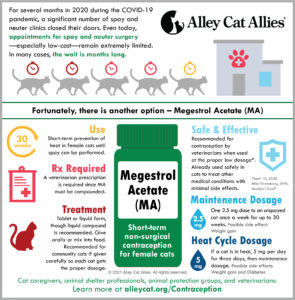Cat Contraception Megestrol Acetate (MA) A Useful Tool During COVID
In 2020, in response to the COVID-19 pandemic, many spay and neuter clinics closed their doors for an extended period of time. Appointments for spay and neuter surgery, especially low-cost, remain extremely limited. In many cases, there is a waiting time of several months.
In communities with low access to spay and neuter, Alley Cat Allies recommends immediate action in the form of a contraceptive, or birth control, for unspayed female cats.
Megestrol acetate (MA) works as a contraception and prevents female cats from going into heat and becoming pregnant. MA has long been prescribed by American veterinarians to treat various conditions in both male and female cats, but before now, it has not been widely used in the United States as a contraceptive.
The use of MA for other purposes, and its use as a contraceptive overseas, have given veterinarians an increased and now solid level of comfort in recommending the use of MA as a contraceptive during the COVID-19 pandemic.
Whether it’s a cat you are fostering or a new stray who has wandered into your neighborhood, many of us experience the uncomfortable position of having an unspayed female cat in our lives when access to surgical spay is limited. Given this unpleasant reality, MA is a welcome addition for cat caregivers.
How Much & How to Give Megestrol Acetate:
- Experts recommend that one 2.5 mg dose of MA be given orally to each unspayed female cat once a week. The simple guideline is “one cat one dose once a week.” For female cats already showing signs of heat, the dose should be given at 5 mg per cat per day for three days only. After that, it should be given in a 2.5 mg dose once a week.
- MA is best given in liquid form added to food that is served on a plastic plate. If served on a paper plate, some or all of the MA might be absorbed by the paper.
- It is recommended that cats be given MA for no more than 30 weeks.
- MA requires a commitment on the part of the caregiver to give the medicine each week in the right amount to each cat. This is most easily accomplished in a household with only one cat, and more difficult in scenarios in which there are multiple cats. If you are giving MA to more than one cat, each cat must be watched to ensure she doesn’t eat her own food with its dose and then wander over to eat another cat’s dose as well.
Cost and Availability:
- Cost and availability of MA will vary, but back-of-the-envelope calculations based on discussions with compounders put the cost of an eight-week course of MA in the range of $3.00 – $5.00 per cat.
- A veterinarian prescription is required for MA. MA has a shelf life of 180 days.
- MA must be compounded, meaning tailored to the needs of a particular patient by a compounding pharmacy. You can obtain a prescription for MA suspended in a liquid compound and flavored in a way that is appealing to a cat (tuna/chicken) from your veterinarian.
- In turn, your veterinarian must obtain MA from a compounding pharmacy. Please speak with your veterinarian about availability of medicines from compounders, as rules vary from state to state.
More Details:
- MA should be given in such a way as to prevent cats from accidentally consuming all or part of another cat’s dose. This ensures appropriate contraceptive protection for the target cat, and it ensures that other cats do not receive unintended doses. MA provides no contraceptive benefit to male cats.
- The use of MA for fertility control in female cats is “off-label” in the US. This means that the FDA has yet to approve MA specifically for the use of fertility control in female cats. Many drugs are used off-label in veterinary medicine, usuallyas is the case here,* after experts have weighed in and made recommendations on safe and effective dosage.
- Some veterinarians are reticent about the use of MA for community cats due to concerns about getting the right dose to the right cat. However, there are veterinarians who are comfortable with and enthusiastic about the use of MA for community cats. These veterinary professionals see MA as a good way to reduce the number of kittens born until clinics are open again to spaying cats as part of a Trap-Neuter-Return (TNR) program.
Conclusion
In situations where there is low access to spay and neuter, as we’ve experienced during the on-going COVID-19 crisis, MA can be a useful tool in providing short-term, non-surgical contraception in female cats.
We each make the best decisions we can with the information we have, and we must recognize that both action and inaction carry risks. Pregnancy and birth carry risks, surgical spaying carries risks, and oral contraception carries risks. Only you and your veterinarian can assess your comfort level with the course of action you choose regarding the health of your cats.
At the doses being recommended, experts indicate that the health risks of MA as a contraceptive are low. Experts feel the health risks to non-target cats who accidentally ingest some MA are also low. That said, it is worth discussing the potential risks and benefits of MA with your veterinarian.


